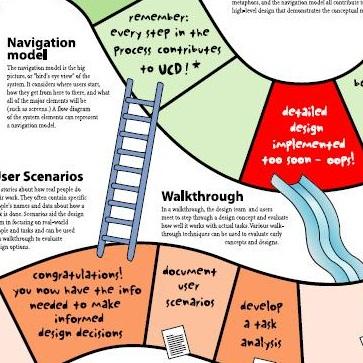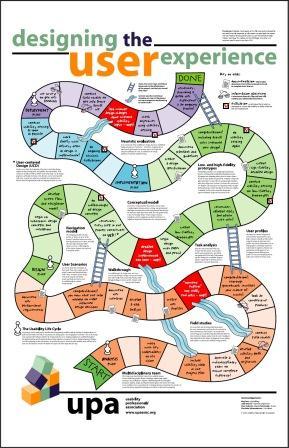
What is User Experience?
We often here friends saying, “This thing is rad!” or “Feeling awesome!” to describe their positive feelings after experiencing something. This process where they interact with people or things are what we called User Experience (UX). To elaborate further, user experience is based on the user-centric idea, emphasizing on the application and aesthetic value of the product or software, including subjective impression, functions, usability, information etc. These factors relate to one another and cannot be separated and the whole thing comes into form the user experience. User experience is subjective and psychologicalal feeling that the user experience while using a certain product (or service). Because it is purely subjective, there are bound to be some uncertainties. Individual difference also suggests that the way each user feels cannot be simulated or reproduced through other methods. However, for a well-defined user group, the similarities or the common ground of user experience can be studied and understood through careful research.
Features of User Experience Design
1. User Experience Design is a new and upcoming inter-disciplinary science
User experience design is not just a science of design, it includes professional fields such as psychology, computer science, and social science. It also covers application, interaction and service of the product, and process, service, events and environmental practice. Therefore, a user experience design team often incorporates professionals of different expertise such as interaction designer, program designer, psychologist and anthropologist etc.
2. User experience design is an innovative design method as opposed to the traditional “shape determines the function” method
For example, button keyboard will change its shape/appearance to accommodate the original structure and size, whereas touch screen virtual keyboard will bring forth a whole new operation experience for users. The traditional design change is merely the change of exterior look while the makeover of user experience can make the product more user-friendly and may even surprise the users.
3. User experience design’s focus has shifted from functional realization and satisfying demands to sheer user experience
Suppose a train company commissions a designer to design its products, then the shape or appearance of train tickets may not be the key focus. The key focus lies in “How to create a pleasant train ride experience” which means you want to make the passengers feel that boarding the train is the beginning of a vacation rather than the destination. This is the core concept emphasized by user experience design!
4. User experience design discovers demands through scenarios and provide solutions
From persona setting to scenario which include names, gender, age, occupation, environment, characters, life style, user experience design use stories to convey its design concept.
5. User experience’s design focus lies in the process of experience, not the final result
Therefore it is imperative that the user understand “what we could do for them and not what we give them.” For example, the sales volume of fast food restaurant decreased significantly, the key problem may not necessarily be the higher cost, but it is not conveniently portable, therefore spilling often occurs. To design a probable solution that rids this problem for good may be more effective than lower the drink price.
The above are some of the basic concept introduction about user experience design. Next, we’ll talk about how exactly should we design it and what are the differences between the current design method and that of user experience design.
Process of User Experience Design
In the field of user experience design, most of what people do is interactive design work. This kind of work involves designers to gain a deeper understanding of the product and user group features based on the result of previous user research. Then the designers proceed with some typical user persona and scenario simulation which is called the personal and scenario design. Through representation of the scenario, the designers summarize and analyze various interactive demands from the process of usage which is called task analysis. Finally, they use flow charts and illustration to present the design result. One thing worth mentioning is that the flow chart is user’s usage process, not program’s logical operation. The difference between the two is that “user flow chart” is created based on user’s perspective, describing the interaction and demands between the user and the product.
However, “program’s logical operation flow chart “ is created based on technological realization with the purpose to satisfy users’ demands. Therefore, we can say that transforming user’s usage process to program’s logical operation process is to satisfy users’ demands, whereas the other way around is to force users to use the product based on the original set design. But the thing is a product created under this kind of design may not be what the users want and may not be a product that is easy to use.
After the explanation, do you have an initial understanding of user experience design? The poster “Designing the User Experience” (illustration 1) published by Usability Professional’s Association (UPA) in 2000 also depicts different stages of user experience design in detail, including activities involved in each phase. For further information, please go on UPA’s website.

▲Illustration 1: Designing the User Experience (source: http://www.mprove.de/)
Below is a list of power point slides and videos about user experience. They are self-explanatory and easy to understand, perfect for beginners who are interested in the field of user experience design:
1. What is User Experience?
http://www.slideshare.net/haunanipao/what-is-user-experience
2. User Experience & Design http://www.slideshare.net/priiti/presentation1-5087292
3. David Kelley on human-centered design http://www.ted.com/talks/lang/eng/david_kelley_on_human_centered_design.html
4. Introduction to User Experience and Experience Design http://www.youtube.com/watch?v=lEvhxJKTQK8
About Author
Gamania UI Designer Center/ Chase
Adopting a User-Center Design approach, the Center seeks to improve upon Group initiated projects to promote Gamania self-produced products and give the players the best user experience.
